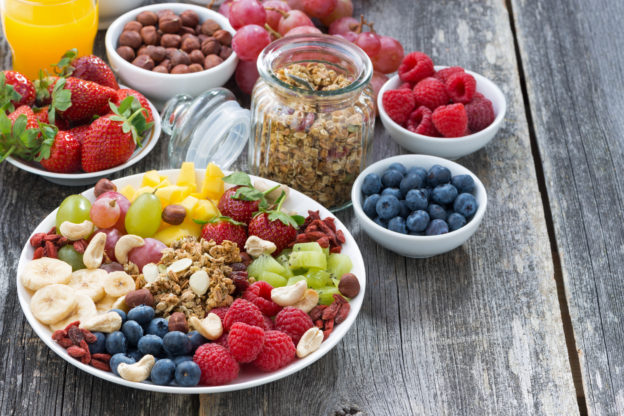Have you ever asked your doctor, what should I eat? For example, many patients want to know what they should eat to lose weight: High fat, low fat? Are carbs good for you or bad for you? I think this exact question represents the dilemma that physicians face when advising their patients about diet. Generally, dietary advice needs to be tailored to the specific needs and goals of each individual patient.
But what if we focused more on the broader principles of a healthy diet which decrease inflammation and can benefit everyone? By doing this we can make general recommendations that most people can try to follow relatively easily and may offer secondary benefits like weight loss, lowered cancer, and heart/brain disease risk.
By emphasizing a wide variety of whole, unprocessed foods and minimizing the intake of refined sugars, trans fatty acids, food additives (and if possible, grown without pesticides , herbicides or other agricultural chemicals) we can decrease inflammation and oxidative stress, greatly reducing free radicals that are often at the cornerstone of disease.
Many of the drugs we use today to treat disease originally were developed using botanicals or natural plants. Why don’t we go back to basics and simply start eating a less processed diet to harness some of the inherent nutritional benefits that a natural diet can provide?
Here are some suggestions to help you get started:
Increase fiber in the diet: a high-fiber diet normalizes bowel movements, which helps you better absorb nutrients and decreases your risk of developing hemorrhoids and small pouches in your colon that can become infected (diverticular disease). It lowers cholesterol levels and helps control blood sugar levels. It also tends to be more filling and can help with weight-loss than lower fiber foods. We are now starting to understand how fiber can improve immunity and help people fight off infections!
- Increase whole grains. Refined “white bread” type products are typically whole wheat that have been stripped of their fiber content. For example, they lack a chemical called Betaine which reduces homocysteine levels. We know that elevated homocysteine levels can increase heart disease risk. For those of you who have Celiac Disease or are gluten-intolerant, there are many whole grains that are gluten-free. Try Amaranth, buckwheat, quinoa, oats and rice.
- Beans and other legumes are also an excellent source of fiber. Eating beans like lentils, whole soy products (tofu, soy milk, edamame), and other legumes have been shown to help maintain good blood sugar and lower cholesterol levels. Fun fact—did you know peanuts are legumes?
- Incorporating more fruits and vegetables in the diet. Fruits and vegetables have large amounts of dietary fiber, not to mention a lot of other good stuff (see more on this below).
- Don’t forget about seeds and nuts! Nuts and seeds are also a good source of fiber, protein, and essential fatty acids. Eating a variety of nuts can reduce cholesterol levels and lower risk of heart disease. The healthiest form of nuts are raw and unsalted. They should be stored in an airtight container in the refrigerator so their healthy fats do not oxidize.
Make your plate colorful! Fruits and vegetables are full of vitamins, minerals, and “phytochemicals” that can help reduce your risk of heart disease, stroke, some cancers, hypertension, osteoporosis and other diseases.
- Specifically cruciferous vegetables like broccoli, Brussels sprouts, cabbage, kale and cauliflower contain chemicals substances which have demonstrated anticancer effects
- Onions and tomato help your blood to be less likely to clot and can reduce blood pressure.
- Mushrooms are immunity enhancers
- Fruits: berries are particularly plentiful of antioxidant pigments that help fight cancer and due to the fiber they can help keep blood sugar stable. Get frozen berries when not in season!
Avoid refined sugars!
- They can lead to intestinal upset
- Associated with weight gain, impaired blood sugar and increased diabetes risk
- Associated with Increased cardiovascular risk; worsens cholesterol and actually makes your blood more sticky and more likely to clot in your arteries
- Impaired immunity (25 teaspoons or 100g of sugar in healthy volunteers was shown in one particular study to decrease the body’s immune cells to engulf bacteria)
- They are empty calories that contain virtually no vitamins, minerals, other micronutrients or fiber.
- It takes more of these calories to feel full!
Eat breakfast!
Several studies have shown that food consumed in the morning was associated with lower total daily calorie intake, which can promote weight loss. Eating breakfast can reduce total and bad cholesterol levels, improve blood sugar and possible improvement in performing mental tasks.
Meat on the side!
- Try to make plant-based proteins, vegetables, and fruits the star of your meal and let meat be the side-dish or the flavor enhancer.
- Pesticides and chemicals tend to accumulate in animal tissue since they are at the top of the food chain.
- Compared to omnivores, vegetarians have lower incidence of a number of chronic diseases
- Eating less meat is better for the environment
- High-quality, sustainably produced eggs, fish, other meats and dairy products in moderation can provide heme-iron, essential fatty acids and vitamins.
Healthy fats
- Avoid margarine and vegetable shortening and anything with trans fats (also known as partially hydrogenated fats). These fats increase cardiovascular and cancer risk.
- Most fats should be monounsaturated (olive oils, avocado, nuts).
- Consume saturated and polyunsaturated fats in moderation.
Gaby AR. Nutritional Medicine, 2011.
ABIHM Curriculum Study Guide 2013
Mayoclinic.org/health-lifestyle/nutrition-and-healthy-eating
University of Illinois at Urbana-Champaign. “An apple a day? Study shows soluble fiber boosts immune system.” Science Daily. ScienceDaily, 17 March 2010.
Dr. Weil’s anti-inflammatory diet pyramid


